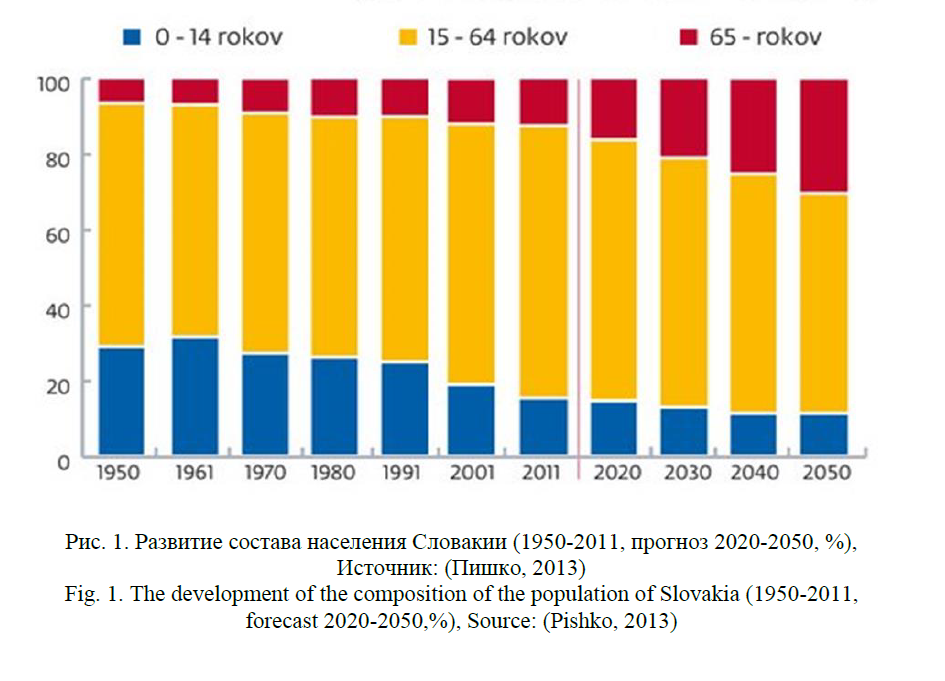Demographic development of Slovakia in the context of European demography
Introduction. Population is a key variable in the functioning of society, and therefore special attention has been and continues to be paid to the study of demographic processes. Despite the fact that the population is a dynamic element of society, which includes several generations, by its nature it is quite predictable. This allows us not only to study current demographic tendencies and analyze current trends, but also to focus on its medium-and long-term development. Foreseeing future development, in turn, makes it possible to prepare by taking the necessary measures that can reduce the response time in the event of adverse demographic development and its impact on the development of the whole society. Materials and methods. The author focuses on the analysis of modern demographic trends and the impact of demographic development on various areas of the state. The aim of the study is to use traditional methods of empirical analysis, such as induction, deduction and synthesis, to answer the question of how the demographic situation or demographic development currently affects society at the global, regional and national levels. The empirical basis of this study includes primary and secondary analyses of demographic trends. Results. In the context of the Slovak Republic and the expected medium-and long-term development, we should note that in some aspects the expected demographic development is even more complex and the expected trends are more negative than in other developed countries of the world or in comparison with other EU member States. One of the decisive factors that have a complex impact on the whole of society is one of the lowest demographic growth rates among the EU countries. This is the result of low fertility, which makes Slovakia one of the fastest ageing countries in the EU. However, the current trend, as well as the reproductive behavior of the population in the long term do not indicate more radical changes in this direction. This factor in the long term will significantly affect the whole society. The gradual growth of the population of post-productive age will be natural and expected, which will put significant pressure on social, medical and pension security. At the same time, as we can see today, such population development has a direct impact on internal migration within Slovakia. Young, educated and economically active people are migrating from backward, underdeveloped and peripheral areas to economically developed areas of the country, which offer better living conditions for this population group. The result of this process is an even greater increase in inter-regional differences due to depopulation development. The demographic change in the nature of these territories is caused by an increase in the post-productive population, which significantly limits the possibilities of economic involvement of the population within the national economy, and this problem is a burden on the state. Discussion and conclusions. Our analysis confirmed the importance of demographic processes for the development of society, as well as their broad-spectrum effect. At the same time, in the study of global, regional, European and Slovak contexts, we were able to identify several groups of serious demographic problems. We note a clear trend that is observed in economically developed countries, and the fact that they reduce the natural population growth, the population is aging, so we can expect that the population growth in these countries will occur mainly due to immigration.



















While nobody left any comments to this publication.
You can be first.
Balazh, V., Feik, M., Gramata, Y., Gusarikova, V., Yankurova, A., Nemets, M., Sollarova, E., Staho, M. and Van'o, B. (2013), The strategy of active ageing, Bratislava, Slovakia.
Blega, B. and Van'o, B. (2007), “Some theoretical and methodological aspects of demographic policy and its concept for the Slovak Republic”, Sotsiologiya, 39 (1), 62-80.
Cherny, Y. “Plohaya demografiya bespokoit”, Slovatskaya natsional'naya gazeta [Online], available at: http://snn.sk/news/zla-demografia-znepokojuje (Accessed 11 April 2017).
Juhaszova, A. and Collar, A. (2013), “Implications of the Demographic Changes in the Slovak Republic”, Political Sciences, 16 (4), 106-119.
Kazansky, R. (2013), Actual problems of research of international conflicts and crises and their solutions, Beliyanum, Banska-Bistritsa, Slovakia.
Koprlova, Y. and Koprla, M. (2010), Analysis of the development and structure of aging processes in the Slovak Republic – specification for the regions, Universitet im. Pavla Yozefa Shafarika, Koshitse, Slovakia.
Masar, D. (2011), Selected issues of the state economy and public finance, Kolledzh v Sladkovichovo, Sladkovichovo, Slovakia.
Pishko, M. Active pensioners are a rare phenomenon. They prefer to sit in front of the TV [Online], available at: https://domov.sme.sk/c/7029869/aktivni-penzisti-su-zriedkavy-ukaz-radsej-sedia-pred-televizorom.html (Accessed 5 December 2013).
Rysova, L. (2009), Regions, regional development, regional policy and achieving economic and social cohesion in the European Union, Universitet im. Mateya Bela, Banska-Bistritsa, Slovakia.
Shproha, B. and Mayo, Y. (2016), Age of population development in Slovakia I. Demographic processes, INFOSTAT – Issledovatel'skiy demograficheskiy tsentr, Tsentr sotsial'no-psihologicheskih nauk SAN, Universitet im. A.Ya. Komenskogo, Bratislava, Slovakia.
Shproha, B., Van'o, B. and Blega, B. (2013), Forecast of population development in the regions of the Slovak Republic until 2035, Prognosticheskiy institut SAN, INFOSTAT – Nauchno-issledovatel'skiy demograficheskiy tsentr, Universitet im. A.YA. Komenskogo, Bratislava, Slovakia.
Van'o, B. (2015), “Current and expected population development in Slovakia and its socio-economic consequences”, Prognoznaya rabota, 7 (3), 273-293.